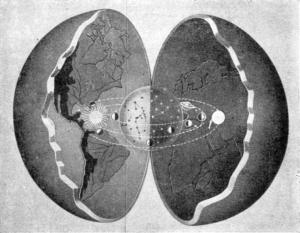
In part 1, I introduced you to Cyrus Reed Teed (1839–1908), the founder of Koreshanity, which holds that the Earth is hollow and that we inhabit its inner surface. It’s called Koreshanity because Teed changed his name to Koresh, the Hebrew version of the Greek name Cyrus. You may recall that the leader of the Branch Davidians, born Vernon Wayne Howell, changed his name to David Koresh for the religious connotations: the Persian king Cyrus the Great is referred to as a messiah in the book of Isaiah, and the Messiah is supposed to be descended from the line of David. Teed, of course, was already named Cyrus, but he, too, was exploiting the religious connotations. After his illumination in the autumn of 1869, there was no doubt that he was the new messiah. At least as far as he was concerned. It took—is taking—a while for the rest of the world.
In the 1870s, Teed practiced medicine in various towns in New York and Pennsylvania, and also visited utopian religious communities—the Harmony Society in Economy, Pennsylvania, in 1873, and the Shaker community in Mount Lebanon, New York, in 1878, becoming a member of the latter. He started his own commune in Moravia, New York, in 1880, where he was also running the family mop business. Both ventures failed, and Teed moved the commune first to Syracuse, New York, and then to New York City. His fortunes improved in 1886, when he was invited to speak at the National Association of Mental Science in Chicago. His talk was such a success that he relocated again, to Chicago, where he reestablished his commune and founded the World College of Life, the Guiding Star Publishing House, and the Guiding Star magazine.
Finally, in 1894, Teed decided to set up a Koreshan colony in Estero, Florida, for which he had big plans: “Estero would be the primary city on earth—or rather in it—with a population of 10 million,” David Standish observes in Hollow Earth (2006). At its height, its population was about 200. But in Estero, Teed had the leisure to return to developing his ideas about the inside-out earth, with the help of a disciple, Ulysses Grant Morrow, who oversaw the experimental results showing the concavity of the Earth reported in The Cellular Cosmogony (1898). (Teed and Morrow were the principal authors of the book, with Teed contributing part 1, “The Universology of Koreshanity,” and Morrow contributing part 2, “The New Geodesy”; a few sections in different editions were contributed by different people.)
Where did Morrow go wrong? Donald E. Simanek of Lock Haven University examined the Koreshan Geodetic Survey of 1897, writing, “I see no evidence of fraud or ‘data cooking’ here. So, if we think the result is in error, what caused that error? If the error isn’t a result of cumulative ‘random’ error, it must be due to a systematic (consistently repeated) error of measurement or procedure.” And he found it in Morrow’s “rectilineator,” which was supposed to provide a perfectly straight line. “Even if the rectilineator had been designed properly, and as rigid as good engineering design would allow, the structure would still not be perfectly rigid.” The resulting sag, compounded by expectation bias influencing which measurements were discarded and which were retained, would account for the published results, Simanek concluded.
Probably the Koreshans were too invested in the inside-out earth to have listened to such a diagnosis, even if it had been offered. How invested? Well, invested enough to have prepared answers to the questions that inevitably spring to mind when contemplating the inside-out earth. Where’s the Sun? At the center of the universe, of course, but it’s invisible; the sun that we see is a reflection. What causes day and night? The rotation of the Sun. Where’s the Moon? The Moon is the Earth’s shell, but the moon that we see is a reflection. The stars and the planets? Reflection from seven disks that float in the center of the world. What’s gravity? “Gravity,” Morrow explains, “really descends from above, consequently it has a tendency to push objects instead of pulling them. Light and heat are forms of gravic energy.” What’s beyond the Earth’s shell? Nothing.
The Koreshans in Estero were involved in a few feuds and fusses—the person who sold them the land on which their community was founded sued for its return; the proprietor of a would-be nearby rival utopian community (the Order of the Crystal Sea) launched a publicity campaign against them; they squabbled with the local Democrats about their 1904 votes for the Republican Roosevelt; and Teed was punched three times in the face by a hotelkeeper over a misunderstood telephone conversation in 1906—but all were resolved, although Teed’s health was permanently impaired by the fight. (Not so impaired as to prevent him from writing a novel, The Great Red Dragon, or, The Flaming Devil of the Orient, “a book at once millenarian (no surprise there), anticapitalist, and apocalyptically racist,” as Standish describes it.) Teed died in Estero in 1908.
But the inside-out earth marches on. The Koreshans continued to publish their magazine The Flaming Sword until 1949, and maintained ownership of their land until 1961; where they once lived is now a state park. There were later German-language expositions of the inside-out earth, Hohlwelttheorie or (better) Innenweltkosmos, associated with Karl Neupert, Peter Bender, Fritz Braun, and Johann Dolanski; unfortunately, my German is not good enough for me to wade through their texts. And Martin Gardner, in a Skeptical Inquirer column in 1988, drew attention to the work of Mostafa A. Abdelkader, who presents a formal mapping that inverts not only the sphere of the Earth’s surface but also the laws of physics to match. “The result,” Gardner exclaims, “is a consistent physics that cannot be falsified by any conceivable observation or experiment!”

